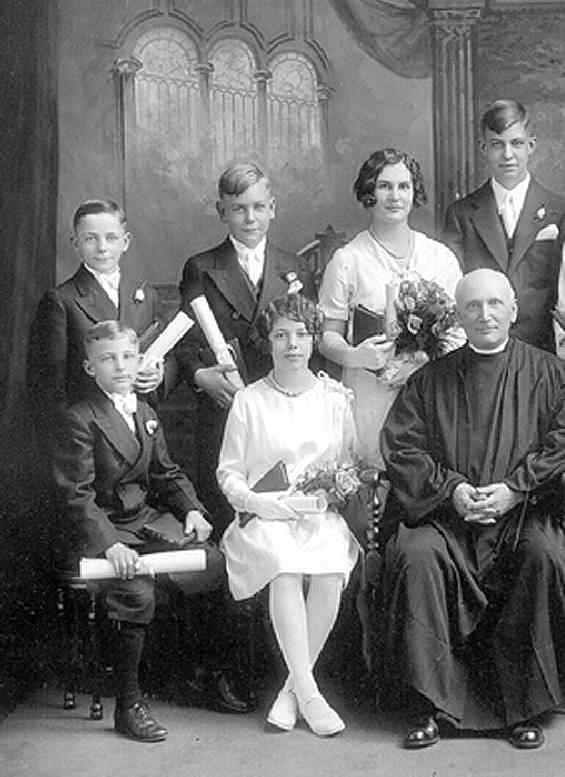
American Boys' Confirmation Suits: Lutheran Confirmation (1932)

Figure 1.--Here is a Lutheran confirmation class, taken in Rochester, New York, in 1932. Most American Lutherans are decendants of German immigrants. The boys and girls, who seem to be between about 12 and 14 years of age, are all dressed very formally for
the ceremony. The Lutheran pastor sits in the center. The girls are dressed in white dresses with white long stockings. Notice the rather grown-up marcelled or waved hair-dos. The boys wear dark knicker suits with white shirts and white ties . Put the cursor on the image to see the rest of the class.
|
Here is a Lutheran confirmation class, taken in Rochester, New York, in 1932. Most American Lutherans are decendants of German immigrants. The boys and girls, who seem to be between about 12 and 14 years of age, are all dressed very formally for
the ceremony. The Lutheran pastor sits in the center. The girls are dressed in white dresses with white long stockings. Notice the rather grown-up marcelled or waved hair-dos. The boys wear dark knicker suits with white shirts and white ties
The Germans constitute the largest immigrant group in America. Germans settled many areas of the United States. Now the Germans themselves are totally Americanized and hardly speak German anymore, except for some older people in Fredericksburg and New Braunfels. Admiral Nimitz was a native of Fredericksburg and spoke only German as a boy. One of the best known German immigrant groups are the Mennoites who settled in southeastern Pennstlvania who incorrently became known as the Pennsylvania Dutch. Germans were divided by the Reformation with the north becoming Lutheran and the south remaining Catholic. I am not sure how this was reflected in the migration to the United States, but there seem to be more American-German Lutherans than Catholics.
American Lutherans
American Lutherans are primarily of German ancestry. There are other nationlities involkved, especially Americans of Scandinavian ancestty, but German Americans predominate. And because the Germans were the largest immigrant group, Lutherans make up a substantial part of American Protestants. There is no single Lutheran church in America. The Evangelical Lutheran Church (ELC) is the largest Lutheran church in America. The second most important is the Lutheran Church - Missouri Synod (LCMS) which is the eighth largest Protestant denomination in the United States. The LCMS is much more conservative than the ELS. The LCMS is important throughout the Miswest. It is not a member of either the National Council of Churches or the National Association of Evangelicals. The LCMS is headquartered in St. Louis, Missouri and has about 2.5 million baptized members.
Studio Portrait
The portrait here look to have been taken in a studio. Notice the church-like backdrop made to look like a parish hall. We note German studios had all kinds of backdrops like this with both scnes inside and outside the church. The fact that the sudio had a backdrop like this suggests that there was a substantial Luther community in Rochester.
Location
The portrait here was taken in Rochester, New York. We do not know the name of the church, but it is almost surely a Lutheran church. I'm not sure at this time about the importance of German settlement or the Lutheran church in the area.
Chronology
The portrait here was taken in 1932. We might have guess a little earlier, but we suspect that the families involved were very conservative and still insisted that boys wear knickers for formal events. After this by the mid 1930s we think thast you will begin to see more boys wearing long pants for Confirmation.
Confirmation
Here is a Lutheran confirmation class (figure 1). The boys and girls, who seem to be between about 12 and 14 years of age.
Confirmation Outfits
The children are all dressed very formally for the ceremony. The Lutheran pastor sits in the center. The girls are dressed in white dresses with white long stockings. The girls where white, but not the minature wedding dresses like the yonger girls ding first communion.
Notice the rather grown-up marcelled or waved hair-dos. The boys wear dark knicker suits with white shirts and white ties.
Some boys wear bow ties, in other long four-in-hand ties. Most of the boys seem to wear long stockings
(black or beige) with their knickers. Earlier almost all the boys would have had dark long stockings in keeping with the formality of the occassion. Note here that one boy (second row, extreme right) is dressed rather sportitely with flashy knee socks with a diamond pattern up the leg. Notice the boutineres--apparently small roses--in the lapels. The girls carry bouquets of flowers.

Navigate the Boys' Historical Clothing Web Site religious pages:
[Return to the Main confirmation page]
[American]
[French]
[German]
[Irish]
[Dutch]
Navigate the Historic Boys' Clothing Web Site:
[Introduction]
[Activities]
[Biographies]
[Chronology]
[Clothing styles]
[Countries]
[Girls]
[Topics]
[Bibliographies]
[Contributions]
[FAQs]
[Glossaries]
[Satellite sites]
[Tools]
[Boys' Clothing Home]
Navigate the Historic Boys' Clothing Web chronological pages:
[The 1920s]
[The 1930s]
[The 1940s]
[The 1950s]
[The 1960s]
[The 1970s]
[The 1980s]
[The 1990s]
Navigate the Historic Boys' Clothing Web style pages:
[Short pants suits]
[Blazers]
[Jackets]
[Kilts]
[Knickers]
[Kneesocks]
[Long stocklings]
[Ring bearer/page costumes]
[Shortalls]
Created: 11:53 AM 10/19/2006
Last edited: 11:53 AM 10/19/2006



